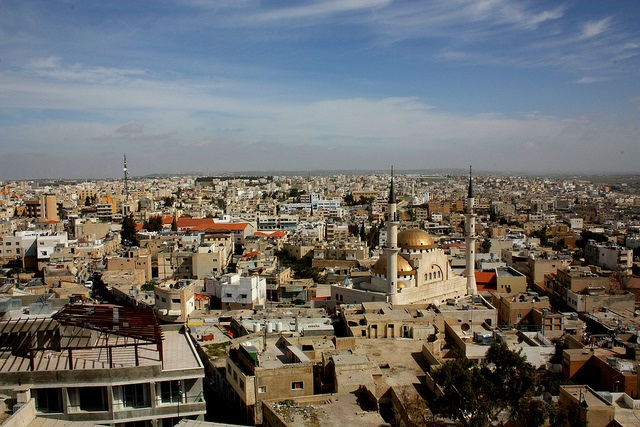 Despite the Hashemite Kingdom of Jordan’s success in avoiding the civil unrest of the Arab uprisings, it faces macroeconomic challenges exacerbated by exogenous shocks since 2011. Jordan’s small, open economy suffered from regional spillovers, including disruptions of natural gas flows from Egypt and a massive influx of Syrian refugees. High and rising world oil and food prices, sluggish global growth, diminished revenue earned from tourism receipts, remittances, and foreign direct investment all contribute to Jordan’s sluggish economic growth in the past three years.
Despite the Hashemite Kingdom of Jordan’s success in avoiding the civil unrest of the Arab uprisings, it faces macroeconomic challenges exacerbated by exogenous shocks since 2011. Jordan’s small, open economy suffered from regional spillovers, including disruptions of natural gas flows from Egypt and a massive influx of Syrian refugees. High and rising world oil and food prices, sluggish global growth, diminished revenue earned from tourism receipts, remittances, and foreign direct investment all contribute to Jordan’s sluggish economic growth in the past three years.
Following the wave of Arab uprisings, Jordan’s growth slowed to 2.6 percent in 2011 after growing an average of 6 percent over the previous decade. Macroeconomic indicators continued to worsen in 2012 as growth remained modest, inflation hit 4.4 percent of GDP, and the budget deficit reached 6.5 percent of GDP. Fortunately, Jordan was able to arrest economic decline with help from external donors, coming in primarily from Gulf countries.
In anticipation of unrest, King Abdullah II responded quickly to social demands by reintroducing petroleum subsidies in 2011, spending close to 3 percent of GDP, and increasing salaries. Subsidized products, particularly low regulated electrify tariffs, contributed to rising government deficit and mounting public debt. In the past three years, the state-owned National Electric Power Company (NEPCO) lost $7 billion, including $5 billion alone in 2013, due to the Jordanian government’s insistence on providing petroleum products and electricity for consumers and producers below market prices. Contributing to the mounting public debt, NEPCO was granted non-cash subsidies to enable it to pay for subsidized gas products (the company’s debt does not appear in the fiscal accounts because it is financed by borrowing with government guarantees). The government has dipped into central bank international reserves reducing them to $8.8 billion in 2012 from $13.6 billion in 2010.
Jordan continues to struggle to meet social demands and ensure economic growth in light of ongoing instability and rising energy demand. Due to its lack of production capacity and inability to keep up with demand, the Kingdom depends heavily on oil and gas imports. Jordan imports 97 percent of its crude oil and natural gas for domestic use, accounting for 40 percent of the state budget. With energy demand increasing at around 3 percent a year and electricity demand growing at more than 6 percent a year, Jordan is facing a shortage of fuel inputs necessary for electricity generation. The alternative has been to substitute diesel and fuel oil to alleviate gas shortages, which comes at a higher price and adds to the budget deficit.
Thus, Jordanian authorities decided to gradually increase electricity tariffs by 2017 and reduce fuel subsidies as a way to ease fiscal pressures. The country developed an economic plan: beginning in June 2012, electricity tariffs increased followed by raising fuel pump prices in November 2012. To ease the social impact, cash transfers were introduced to 70 percent of the population. In addition, electricity tariffs for select economic sectors and higher-income households increased by 15 percent since May 2012. Such austerity measures granted Jordan a $2 billion loan to be repaid in thirty-six months as part of a Stand-By Arrangement (SBA) with the International Monetary Fund (IMF).
Jordanian authorities recognize the need to develop alternative energy supply routes and diversify sources of fuel. Prior to recent pipeline bombings and sabotages in the Sinai Peninsula, Jordan imported 80 percent of its natural gas from Egypt. Recently, the Jordanian government took steps to mitigate Egyptian gas shortfalls and ease energy import costs by building a new $65 million LNG import facility in the port of Aqaba, set to come online by the end of 2014. The facility, funded by Kuwait Fund for Arab Economic Development (KFAED), will feature a floating regasification plant, and under the agreement Royal Dutch Shell will supply 16.7 million cubic meters (mcm) of LNG a day. Completing the LNG terminal in Aqaba’s Special Economic Zone (ASEZ) remains a priority for securing gas supplies and for saving Jordan an average of $500 million a year. Another strategy for securing gas supplies has been through geopolitical cooperation tapping Eastern Mediterranean energy sources evident in the contracts between Jordanian gas companies Arab Potash and Jordan Bromine and Israel’s offshore Tamar gas field. A deal brokered by US-based Noble resulted in a 15 years supply arrangement for 1.8 billion cubic meters of gas beginning in 2016.
Although the government has taken significant measures to reduce energy subsidies, they must continue to reform electricity tariffs. The current electricity tariff structure for residential consumers is based on monthly consumption levels yielding seven cost brackets. To date, tariffs increases have been limited to industries and specific sectors, but do not include households in the bracket constituting monthly consumption of 600 to 1,000 kilowatt-hours (kWh). According to World Bank estimates, residential consumers utilize about 35 percent of total electricity. The impact of the recent tariff increase is expected to affect less than 10 percent of households, limiting additional annual revenues to JOD 3.5 million. By increasing tariffs on different households and sectors brackets, the government can raise more revenue.
Jordan should continue to reform its energy subsidies and develop domestic sources of energy. But given economic constraints resulting from demographic growth and a large influx of refugees, Jordan will need to invest in renewable energy and in construction of new power plants to ensure economic prosperity. With close to a million UNHCR-registered refugees from Iraq, Somalia, Sudan, and 600,000 Syrian refugees alone—not to mention a young population growing at 2 percent a year—the country will struggle to address pressures on already scarce resources like electricity, water, and housing. Unfortunately, there is no quick fix to Jordan’s energy crunch, but authorities need to address the problem soon to avoid renewed unrest.
Svetlana Milbert is the assistant director for economic research at the Atlantic Council’s Rafik Hariri Center for the Middle East.
Image: A view of the Amman cityscape. (Photo: Flickr)

